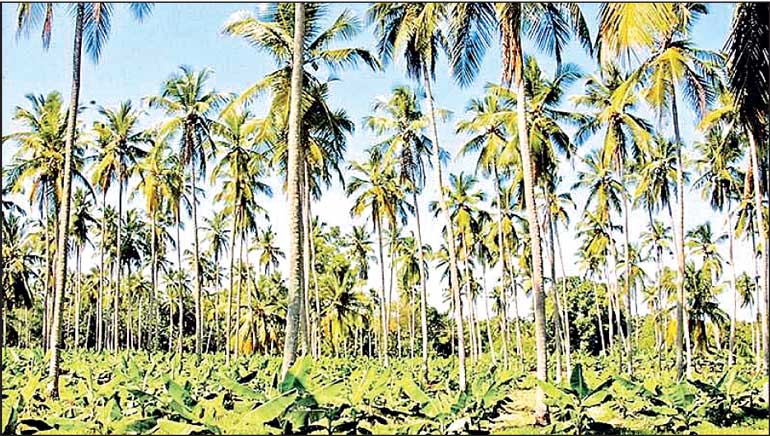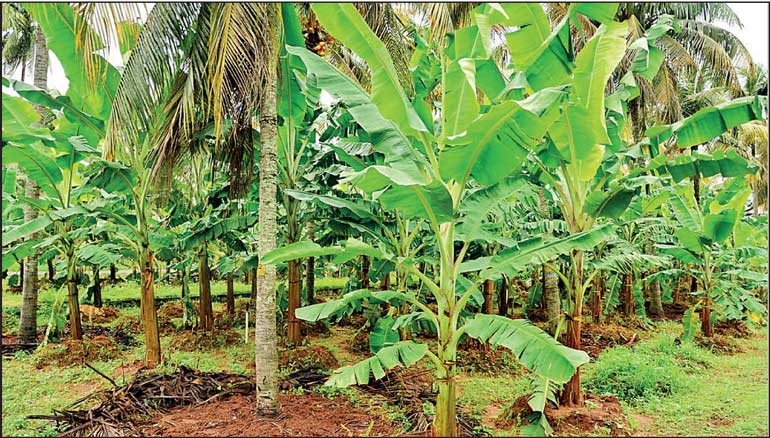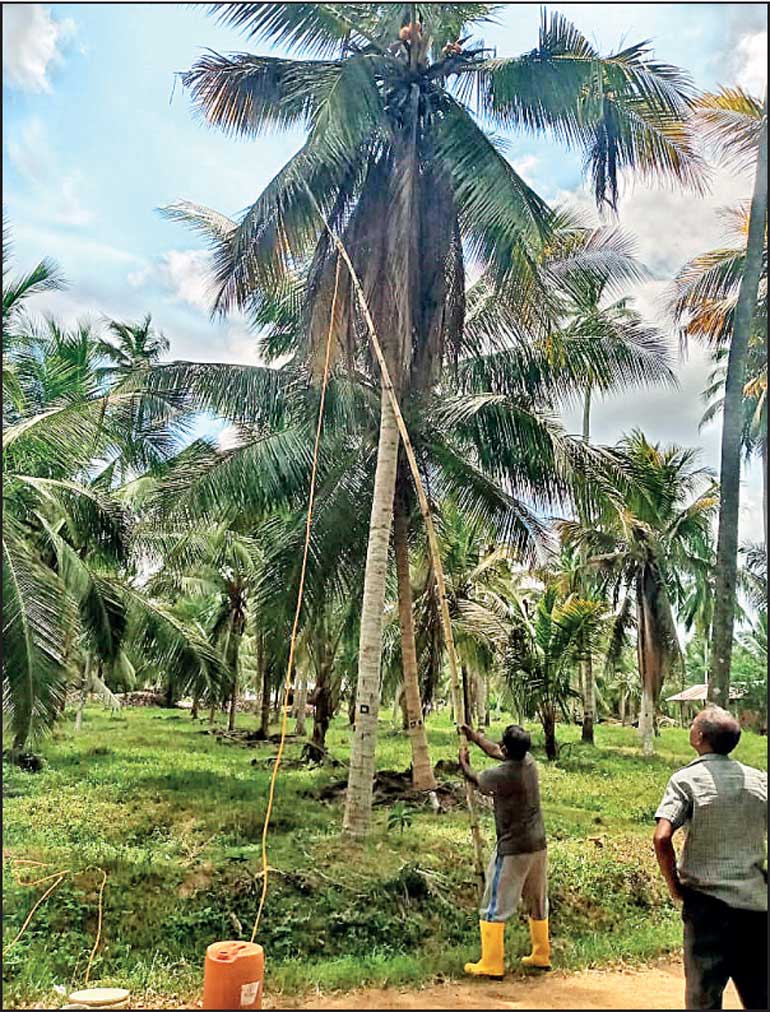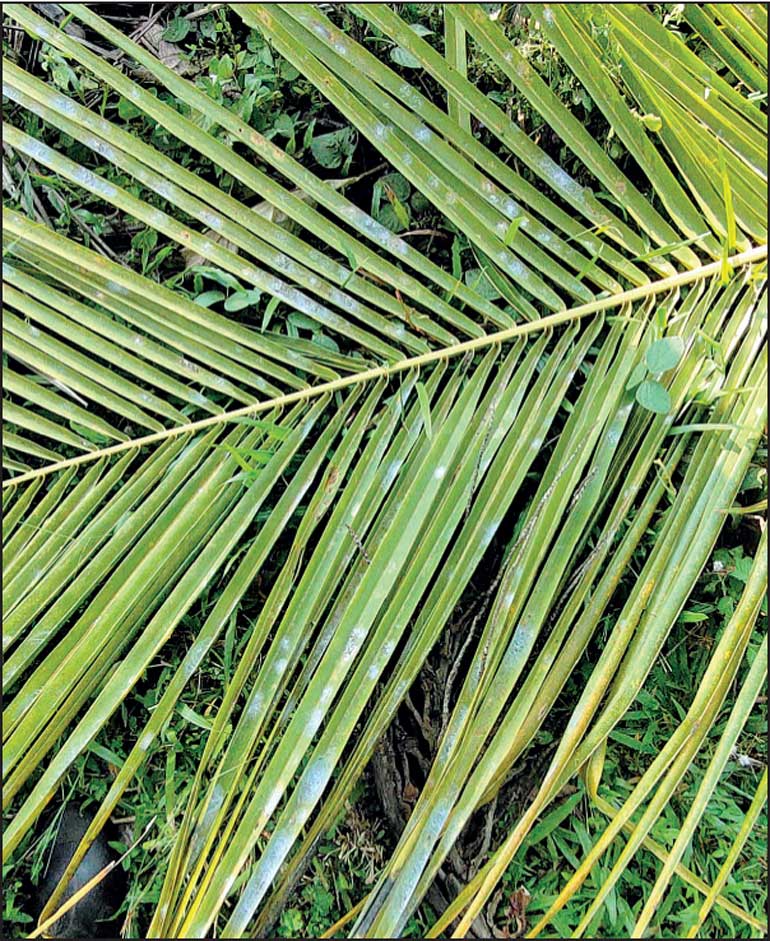Tuesday Mar 04, 2025
Tuesday Mar 04, 2025
Wednesday, 28 December 2022 00:00 - - {{hitsCtrl.values.hits}}

Coconut – revered as kap ruka or celestial tree

Intercropping with coconut enhances land productivity
|
Unless climate-smart agricultural habits are adopted, coconut production which is already threatened by whitefly attacks and lack of fertiliser, is at stake with possible soaring of nut prices, warns stakeholders committed to the wellbeing of this kap ruka or the celestial tree.
By Randima Attygalle
 |
| Trees infected by whitefly disease being treated at KPL |
 |
| Whitefly attacks
|
Covering a land area of 1.1 million acres and producing around 3.3 billion nuts annually, coconut, revered as the ‘kap ruka’ or the celestial tree, is the second major crop in the country after paddy. Coconut is uniquely positioned in Sri Lanka as a commercial crop of which 70% is used for local consumption. To strike a balance between consumption and exports (which is only 30% at present) and to adapt to unprecedented climate change and other environmental threats, coconut, thus calls for Good Agricultural Practices (GAP).
Out of the total coconut acreage, only about 200,000 acres (18%) are coconut estates with more than five acres. The balance 900,000 acres which constitutes 83% of the total land cover are below five acres. These smallholders or home gardens are distributed among one million growers. “Very often these small-scale holders do not realise that their coconut gardens too need to be developed to commercially viable units, irrespective of the land extent, for which GAP such as soil and water management, fertiliser management, inter-cropping, etc. are required,” says Coconut Cultivation Board (CCB) Chairperson Madhavie Herath. The CCB, as its Chairperson explains, is committed to taking GAP know-how to the grassroots level through their field officers.
Increasing production
The competition in the market for coconut between the industry and consumers and the mismatch between the demand and supply drive the nut price up each day, says Herath. “This has a cyclic effect as people will find it difficult to spend on coconuts and the industry will find it difficult to buy nuts at a higher rate and sell for a competitive price in the international market.” GAPs, therefore, are the answer to increase productivity in the short-term and to increase the extent long-term, says Herath. “If not for the hybrid variety, it takes about five years to bear nuts, therefore in the short-term we need to increase the yield from a tree. When the production is increased, a reasonable price will be decided which will benefit both the customer and the industry,” says CCB Chairperson who goes on to note that the Coconut Research Institute helps CCB take the latest research findings on high yielding varieties to the growers. “We hope to increase annual nut production to at least 3.6 to 3.8 billion by 2025 for which we encourage all coconut growers, irrespective of the acreage, to adhere to best practices that CCB helps disseminate from sapling stage to maturity of a coconut tree,” Herath remarks.
Finding a niche market
Coconut is grown in 90 countries in the world and we are the fourth largest coconut producer in the world behind India, Philippines and Indonesia. A collective ‘Made in Sri Lanka’ branding campaign catering to the demands in the European market is essential if our coconut is to capture a sizable European market, maintains Herath. “Our production cost is still very high and allocation for research and development is also not sufficient,” says CCB Chair who also cites lack of information and analysis, red tape in bureaucracy and archaic laws and regulation which are not flexible to cater to modern trends as bottlenecks which prevent Sri Lankan coconut from securing its due place. “Ours is such fertile soil and whatever that grows out of it is always the best in the world, but sadly we are not committed enough as a nation to make the best out of our crops and position them as niche products in the global market,” remarks Herath.
Research
A climatic-sensitive tree, coconut requires proper management to sustain its vigour.
Coconut Research Institute (CRI) is currently conducting research on breeding coconut with the characteristics of drought tolerance, resistance to pest attacks, good kernel quality including high milk yield and high oil yield. “We have already released six improved cultivars which have different yield potentials and characteristics. To facilitate mass production of seeds/seedlings, we have established four seed gardens, increased the mother palm pool and started setting up another two new seed gardens in collaboration with the private sector. Measures are also underway to establish more seed gardens to meet the demand of the hybrid seeds,” explains CRI Deputy Director (Research) Dr. Sarath Idirisinghe. CRI currently produces about 1.5 million seed nuts annually and issues them to CCB for seedling production. CRI has planned to produce one million hybrid seed nuts by 2024.
The management of coconut lands as Dr. Idirisinghe points out, has been very poor, particularly those of the smallholders and CRI among their other initiatives to empower growers on GAP is now promoting the use of 50% inorganic + 50% organic manure towards sustainable soil fertility management. New research is also under way to introduce soil conditioning material including carbonised planting materials and compost materials to enrich the fertility level of soil.
|
Pest management
CRI has also developed integrated pest and disease management (IPM) packages to manage the pests and diseases and these technologies are disseminated to the growers. “Measures are underway to establish more predatory mite breeding laboratories in the country to produce more predators to release to the growers which is in very high demand for the control of coconut mites. We are also researching to identify new predators to control coconut mite or other control measures,” Dr. Idirisinghe says. New nano-gel based pheromones are also being developed by CRI for Red Weevil (RW) control which is a major threat to the coconut seedlings and young plants.
Recurrences of extreme climatic changes have severely affected the coconut cultivations in the country and the low rainfall received during the past several years has caused significant damages to the coconut palms. Therefore, studies are underway to identify the drought resistant varieties, pest and disease resistant varieties due to changing climatic conditions.
The present whitefly attack which was first reported from Kegalle District, has now been spread to several other districts in the island causing notable economic damage to the coconut cultivations. CRI’s research, according to Dr. Idirisinghe, has identified the life cycle of the pest and severity of attacks. “We have recommended chemical insecticides, bio-based insecticides and have started to identify and breed predators to control the pest. In addition, we are also in the process of spraying chemicals to infested palms in collaboration with the CCB in Dankotuwa, Wennappuwa and Nattandiya areas as a pilot project. Based on the outcome of the pilot project, we expect to give better recommendations to manage the white fly attack in the rest of the areas in the country.”
|
Intercropping and livestock
The productivity of coconut under monoculture is generally low, however, the land productivity can be increased by intercropping and integration of livestock, says Dr. Idirisinghe. CRI has recommended coconut-based agroforestry systems using fruits such as rambutan, mango, papaya, pineapple and spices such as pepper, coffee, cinnamon and cocoa and livestock such as cattle, goat and sheep. “These practices will help change the micro climatic condition of the coconut plantations which will improve the yield. Further, agroforestry systems using Gliricidia, Calliandra and wild sunflower have been proven as potential for degraded coconut soil improvement.” Mixed-cropping systems also reduce the risk and uncertainty of incomes. Integration with livestock requires establishment of pastures and fodder varieties. Thus, livestock rearing can simultaneously increase land productivity and farmer-income which is an ideal combination for sustainability of soil fertility and to reduce rural poverty, points out Dr. Idirisinghe.
|
Climate changes
Climate change has had a significant impact on the Sri Lankan coconut industry. High temperature affects the pollination resulting in a few nuts per bunch and button nut fall, aggravating the effect of water scarcity. “Although the technology is in place for minimising the drought effects in coconut plantations and the farmers are trained to implement them, many do not seem to follow recommended practices,” says Dr. Idirisinghe. He further says that CRI has set breeding objectives to develop high yielding hybrid varieties tolerant of climate change. Experiments are also being done by CRI to identify the potential of using carbonised plant materials for soil moisture conservation and for increasing the nutrient use efficiency, changing the micro climate, and carbon sequestration.
|
Unaffordable fertiliser
Unless the present whitefly pest devastation is arrested soon and a treatment process is implemented as a national program covering small holders as well, 2023’s coconut production could be seriously threatened, warns the Coconut Growers Association of Sri Lanka. Its President, Jayantha Samarakoon tells the Daily FT that the diseases could eliminate over 1 million coconut trees and the annual production could drop by 10-20% which is equivalent to 300-600 million coconuts per year. This will increase the price of coconut further.
“Fertiliser issue is also very serious as most coconut growers have not fertilised their coconut estates for more than two years. Less than 5% of growers could afford the current price of coconut fertiliser which is at Rs. 25,000-30,000 per 50 kg bag. If we do not fertilise coconut trees the yield will drop drastically in the coming year and we may face severe shortage of coconut and a price hike in the domestic market. Therefore, it is very important for the government to make available coconut fertiliser at a reasonable price (Rs. 10,000-15,000 per 50 kg bag) in 2023.”
Annual fertiliser requirement for the coconut sector is about 80,000 MT. This includes 20,000 MT of Urea, 40,000 MT of MOP and 20,000 MT of ERP which is available locally. “Urea and MOP are to be imported and made available through fertiliser companies at the above reasonable price,” says Samarakoon.
Around 1.8 billion coconuts are required for domestic consumption per year while the coconut processing industry needs 1.2 billion coconut per year. Coconut processing industry, as Samarakoon points out, generated an export income of $ 834 million in 2021 and the estimated export income for 2022 would be about $ 900 million, he says. In 2021, coconut product export contributed 6.7% of total export and about 0.7% to GDP.
|
Market-oriented interventions
In a bid to strengthen the state mechanism to assist growers, CDA, CRI and CCB should introduce a market-oriented service delivery mechanism to meet the requirements of coconut growers of various levels, more effectively, maintaining Samarakoon. This could include digitalisation of services and product-delivery methods, on-line applications to disseminate specific knowledge and advice to individual coconut growers which could significantly reduce the cost of operation and production, he says. “We have also requested successive governments to provide capital investment for coconut growers to modernise irrigation systems and smart and targeted application of fertiliser. In addition, we have requested subsidy schemes for soil fertility improvement and moisture conservation to be continued for small holders.”
|
Climate-smart agriculture
Added to the fertiliser and agrochemical shortage, the economic crisis, labour scarcity, high labour wages and unavailability of skilled labour have placed many large-scale coconut plantations in predicament. The whitefly menace has become a double whammy. To counter the disease, Kurunegala Plantations Ltd. (KPL) is practicing yellow sticky traps on coconut trunks and spraying pesticides, neem oil, and soap mixtures to control them, says its CEO Dr. S.M.M. Samarakoon.
Coconut production of Sri Lanka is mainly rainfed and vulnerable to climate change manifested in unpredictable rainfall patterns and high temperatures. “Sustaining the yield of coconut has been challenged with low soil fertility with the inadequate chemical fertiliser application. KPL has cultivated more than 15 intercrops across the different agro-ecological zones as means of crop-based climate-smart agriculture. Coconut is highly vulnerable to drought as well. However, inter-crops of KPL, such as cashew, rambutan, mango, durian, and guava have shown very good performance during low rainfall with dry climatic scenarios and have compensated for the yield loss of the coconut due to dry climatic conditions,” says Dr. Samarakoon who reiterates on the importance of combining coconut with intercrops, for the sustainability of income per unit of land.
In addition, drip irrigation and jet irrigation, building of ponds, husk pits, burying husks, cover cropping, etc. are practiced by KPL to conserve moisture throughout the year, he says.
Being an island with inherent qualities, Sri Lankan coconut is well-reputed in the global market. However, heavy domestic consumption of coconut is limiting the value addition and export earnings of the crop, says KPL’s CEO.
Discover Kapruka, the leading online shopping platform in Sri Lanka, where you can conveniently send Gifts and Flowers to your loved ones for any event including Valentine ’s Day. Explore a wide range of popular Shopping Categories on Kapruka, including Toys, Groceries, Electronics, Birthday Cakes, Fruits, Chocolates, Flower Bouquets, Clothing, Watches, Lingerie, Gift Sets and Jewellery. Also if you’re interested in selling with Kapruka, Partner Central by Kapruka is the best solution to start with. Moreover, through Kapruka Global Shop, you can also enjoy the convenience of purchasing products from renowned platforms like Amazon and eBay and have them delivered to Sri Lanka.
Discover Kapruka, the leading online shopping platform in Sri Lanka, where you can conveniently send Gifts and Flowers to your loved ones for any event including Valentine ’s Day. Explore a wide range of popular Shopping Categories on Kapruka, including Toys, Groceries, Electronics, Birthday Cakes, Fruits, Chocolates, Flower Bouquets, Clothing, Watches, Lingerie, Gift Sets and Jewellery. Also if you’re interested in selling with Kapruka, Partner Central by Kapruka is the best solution to start with. Moreover, through Kapruka Global Shop, you can also enjoy the convenience of purchasing products from renowned platforms like Amazon and eBay and have them delivered to Sri Lanka.